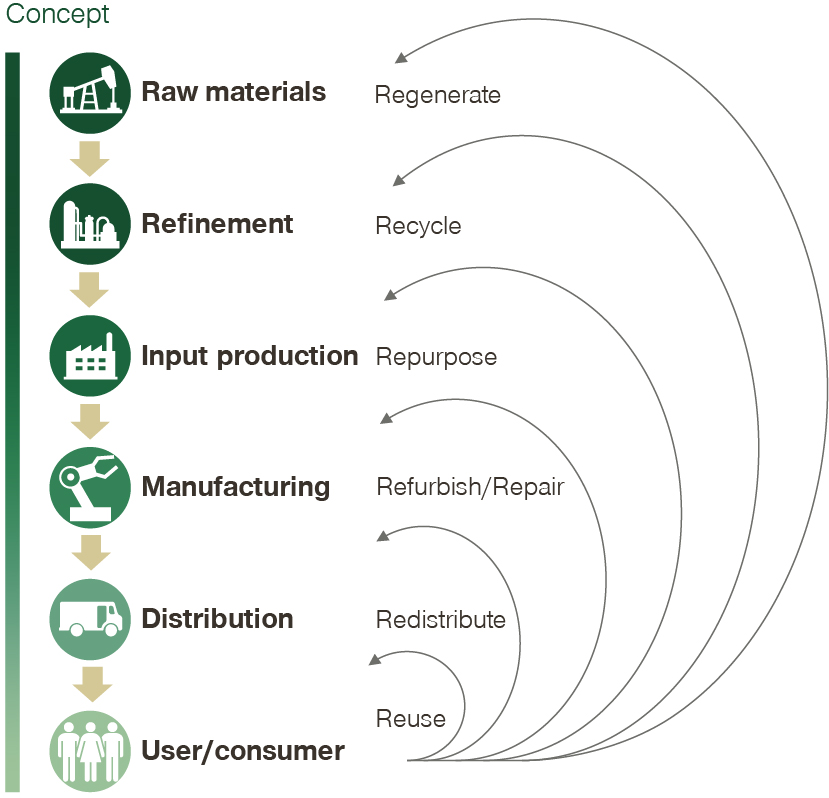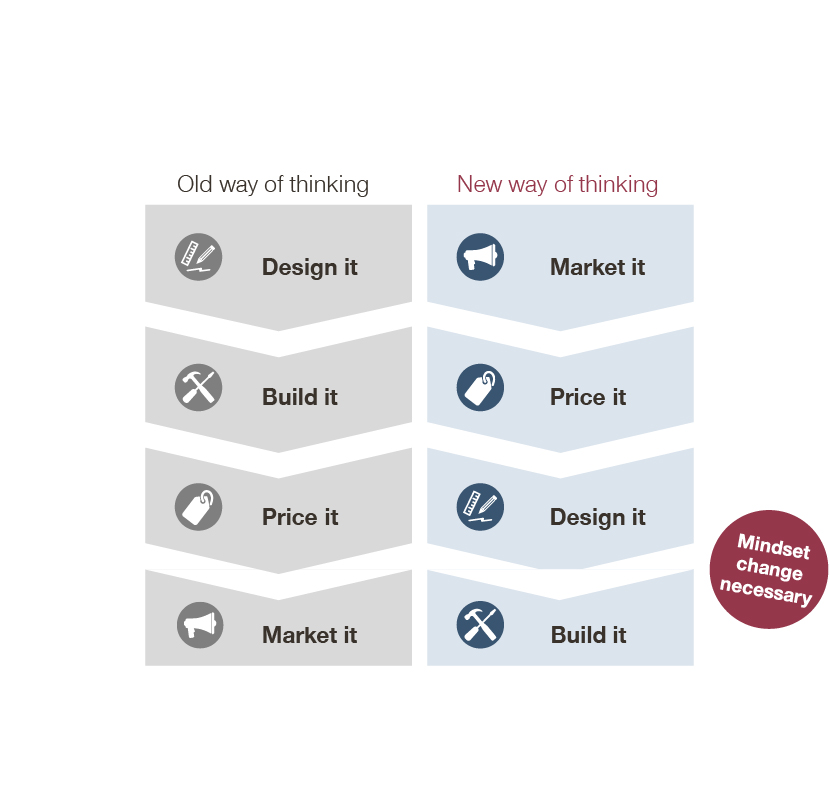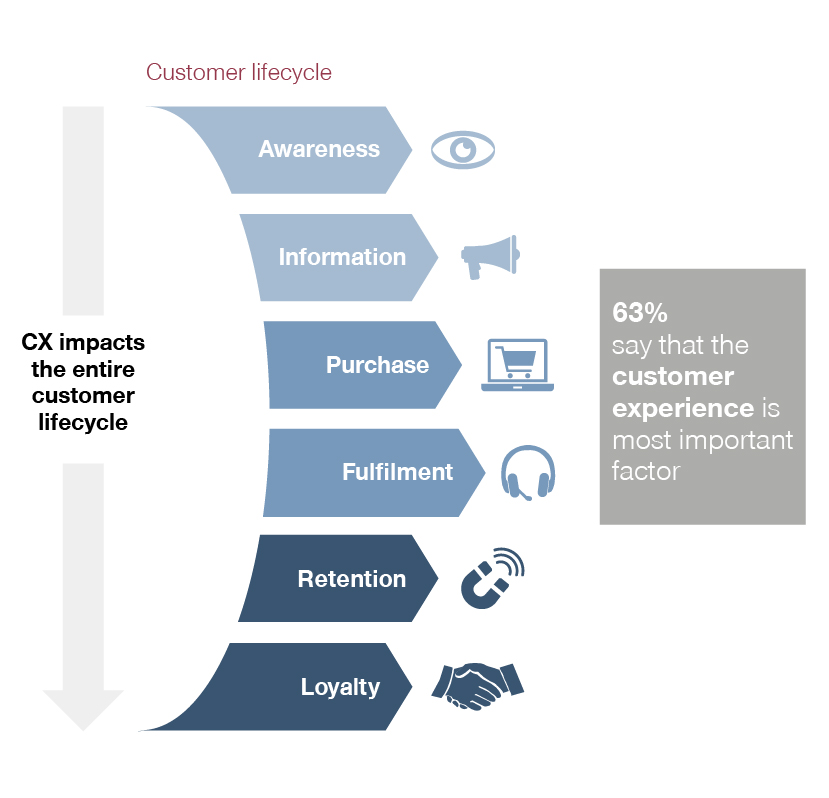Across industries, sustainably-minded and mission-driven companies are developing new sustainable products and services and bringing them to market, however, there are many unknowns regarding the commercial aspects – especially around monetization. New product and go-to-market strategies require a new mindset for success. For one, the potential customers for sustainable products may not be the same ones a company has historically served. Changes to the business model, product development as well as customer engagement may be required for companies in the most advanced phase of their sustainability transformation: Thrive.
![]()
If you’re not quite there yet, find out more about earlier phases of sustainability transformations in our blog articles about phase 1 – embark and phase 2 – innovate.
Our research determined that consumers commonly have a higher willingness-to-pay for sustainable products. However, tailoring products to a new audience, determining the associated revenue, and selling them through potentially novel channels can pose roadblocks for companies in their launch efforts. Though, workforces have recently increased their demand for change and concrete commitments to improve companies’ emission footprints – driving the sustainability transformation from within – commonly, deeper and more profound changes are required to ensure the success of an organization than simply tapping into the wave of enthusiasm.
In the following, we focus on sharing best-practices and approaches across three vital fields of action when it comes to substantially transforming a business towards sustainability.
Field of action #1: Determine how sustainability affects your business model and how much transformation is required
The traditional economy of the past centuries, built around the concept of take-make-waste, loses its viability more and more quickly as societies across the globe recognize the urgency of climate change and demand action. Hence, sustainability increasingly becomes a driver for growth, innovation, resilience, and competitive advantages.
Setting ambitious net-zero or even negative emission targets is possible, and key to viable long-term business strategies. Rethinking conventional methods of product design, production, ownership models, customer engagement as well as end-of-lifecycle planning becomes a must with new materials, digitization, and financing options emerging. Companies that embrace the concept of sustainability and put its vision first in everything they do can build and shape their own position in the market – and therefore get ahead of the curve.

The leasing of investment goods is common practice in many sectors. However, new modes of offers are entering the market that provide even more flexibility for customers/consumers to move their capital expenditures (CAPEX) more and more towards operational expenditures (OPEX) e.g., in the form of subscriptions – accelerating the trend of the sharing economy. Some vendors even go so far as to offer pay-per-use or pay-per-produced piece modes – common practice in software – that fully capture usage-based compensation and thereby decoupling from the common investment-in-capital-goods philosophy. At the same time as offering more flexibility to customers, the manufacturer or provider keeps full control over the lifecycle of the product and can therefore make sure it is properly maintained throughout and recycled or repurposed at the end of the lifecycle – following the principles of sustainability. Not all products or services are suited and not all organizations are capable of transforming towards such Product-as-a-Service, circularity or multi-reuse offer strategies plug-and-play given also the balance sheet implications. Hence developing an appropriate business model concept along your customers’ needs and proper testing is crucial to ensure success later on. How can this be tackled successfully? You can use these key principles when re-thinking your business model:
- Think about your target customers’ needs or pain points – try taking the external view not only when developing a product or service but also when evaluating a business model. Having the requirements in mind ensures that your offer’s features meet a particular customer need and in result, you’ll have the right vision to adapt your business (model).
- Draw inspiration from best-in-class examples – also beyond your own industry. It is essential to challenge your internal mind-set to develop new innovative ideas; while your peers might also just start their transformation, your customers’ markets or other sectors may already be miles ahead. Leveraging benchmarks can provide unique insights.
- Apart from matching your capabilities to the customers’ needs and identifying gaps (e.g., re-skilling the workforce), the next crucial step is to clearly understand and quantify the concrete benefits to get a sense of the value-created to appropriately structure your value proposition and monetization focus.
- Testing the offer with selected customers is especially important as e.g., certain price models or modes of engagement may not be very common (yet) in more traditional industries. Another way to increase market acceptance is to enter some form of co-development engagement or partnership with trusted customers and suppliers to create early promoters and boost positive perception of potential value-sharing agreements.
- Once you have selected your vision for the future business model, you need to shift your view back to your own organization, assess the feasibility (e.g., financial/budget implications), and define the implementation as well as the development roadmaps to establish clear guidance for i.e., governance structure, roles, setup, and training.
Before launching or re-inventing a business model, it is vital to understand all consequences for the organization. There’s often more to it than simply determining the “what” and the “how” of e.g., changing a price model from a one-time transaction plus aftersales to recurring payments for product-as-a-service offers. Developing a proper vision and modeling the impact on your company in terms of business plan, financial situation, and stakeholders as well as investors is essential. This process can be very challenging and complex as it is inherently cross-functional, so selecting the right internal and external partners is key.
Field of action #2: Determine pricing, monetization, and revenue models for your sustainable product creation and services
Most innovations fail or do not achieve their commercial goals – several studies from our colleagues pinpointed the number to around 72 percent. The reason: An old-fashioned way of managing innovations. Especially in very technical professions and backgrounds, the mindset taught in engineering schools is still: 1. Design it, 2. Build it, 3. Price it, 4. Market it.

More often than not, companies find that what they have designed and built in the first two stages does not reflect real customer preferences or will not meet customers’ needs. That can be a bitter pill to swallow, so they either launch the product and sell it for a discount or go back to the drawing board.
It requires significant change management and push from the top (management) to transform an engrained mindset, but it is necessary to successfully monetize innovations. We help organizations to establish a new way of thinking: 1. Market it, 2. Price it, 3. Design it, 4. Build it.
By putting consumers’ preferences first and focusing the development process on the customers’ needs, organizations can significantly improve their success rate – this also applies to sustainable innovations! From the beginning, the product development, commercial strategy, and tactics need to be tailored to fit the market requirements. Even though sustainable innovations may not be fundamentally different in this regard, there are certain particularities and alternative angles to consider, such as additional stakeholders along the value chain or the continuous measurement and accounting for emissions.
Over the years, we have supported companies across different sectors in successfully introducing their products and services to the market – including many sustainable innovations.
To learn more about how to successfully monetize innovations, check out our blog article on this topic or take a deeper dive into the topic in the bestseller “Monetizing Innovation”.
Field of action #3: Determine the right steps to adapt your customer engagement model
When it comes to sustainability, consumers – not only in B2C but also in B2B industries – increasingly demand purpose and active engagement with brands or providers. Our research has shown various times that customer experience (CX) is one of the most important factors when it comes to customer retention. Having an optimized customer experience strategy translates into significant increases in topline, customer satisfaction, and decreases in cost-to-serve.

Circular or multi-use focused business models have different CX requirements than traditional one-time-transaction focused businesses. It is therefore essential to include all relevant stakeholders and to make sure all customer-facing functions within the organization can live up to the new CX. We see the following success factors as fundamental requirements to improve an organization’s CX:
- Put yourself into your customers’ shoes: An in-depth/outside-in review of a customer’s journey from first awareness to purchase, fulfillment, and later retention phases is vital to get full transparency of how customers perceive your business.
- Focus on the most relevant segments first before branching out: There are many ways to segment a business and it’s easy to get distracted as there is often no unique customer journey. Nonetheless, make sure to include all relevant channels – while your direct interactions with customers are important, commonly a significant part of the CX also includes indirect, partner, or distribution channels.
- Define your CX vision and iterate: Set a clear vision for each of the CX you have short-listed, map out the way to get there, and identify the capability gaps you need to close.
- Personalize your CX and emphasize value: Seek to understand which granular drivers create the most value for each of the (customer) segments so you are able to mix and match communication and experiences to fit the needs.
- Set up clear KPIs to steer your organization: Updated CX may change the way of working in several parts of your organization and it’s critical that your team is fully on-board. That means: Employees need to be informed, trained, and incentivized based on clear KPIs to make sure the intended change is successful.
All in all, customers demand more active participation when it comes to brands’ efforts on sustainability. At the same time, ownership of goods becomes less important as customers get more accustomed to the ever-increasing trend of the sharing economy. Organizations that are mindful of these changes and leverage the opportunities of digitization as a back-bone for their transformation towards sustainability will truly be able to thrive for years to come.
This article concludes this series on the distinct phases of sustainability transformations. Sustainability itself is one of the most crucial topics of the 2020s and beyond – it is a driver of innovation and opportunity for some, and a significant challenge for others that resist the imperative change. Embracing the concept and adapting one’s commercial strategies as well as business models is vital to an organization’s long-term viability. The approaches mentioned in the articles are not exhaustive, however, we hope they can serve you as a foundation and food for thought, in whichever phase of the sustainability journey you find yourself.
Please get in touch if you have any comments, questions, or remarks.
Read more from the series:









